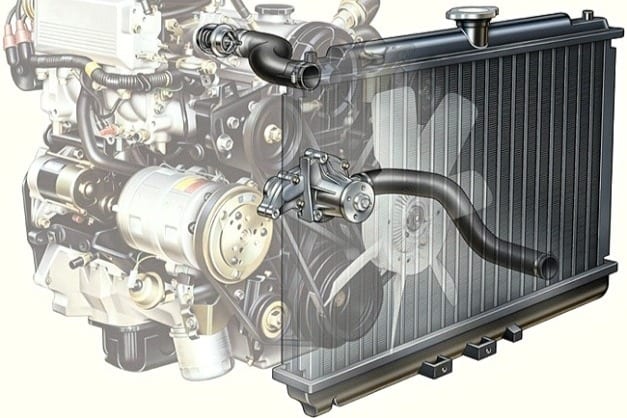
What is a radiator and what is it for?
Content
- General concepts, purpose
- Types and arrangement of automotive radiators
- What is it for in the car?
- What does the cooling efficiency depend on?
- Radiator design
- Types of radiators
- Technical requirements
- Additional options
- What does the cooling efficiency depend on?
- Damage to radiators: causes, prevention
- How to repair a radiator
- Which is better: repair or change
- How to operate?
- Why do you need to regularly flush the cooling radiator in a car?
- Extending the life of a radiator: flushing outside and inside
- How to flush a car cooling radiator
- Which radiator is better?
- Radiator leaks: what to do
- Causes of a radiator leak in a car cooling system
- What is the danger of antifreeze leakage from the cooling system of a car
- What to do if the cooling radiator is leaking
- What to do in case of large damage and leaks of the cooling system
- How to glue the plastic parts of the cooling system with a leak
- Is it possible to solder aluminum radiators and how correctly
- Eliminating antifreeze leakage in the cooling system using a special sealant
- Related videos
- Questions and answers:
Radiator - a car part that is installed in the engine compartment. It provides continuous cooling of the engine.
How is it arranged, what is it for, what types of radiators are there, why does it fail, how to care for it, and how to choose the best modification? We will deal with all the nuances in more detail.
General concepts, purpose
In the process of the car, all its mechanical components are heated. In individual compartments, this figure reaches more than one hundred degrees. And the main unit, which due to elevated temperature will quickly fail, is the motor.
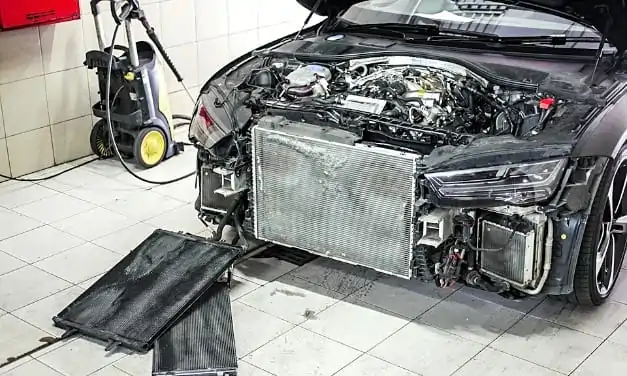
To prevent moving engine parts from deteriorating, they must be cooled. For this, the engineers of each automaker develop and install a cooling system.
Cooling radiator - a metal heat exchanger inside filled with antifreeze (or antifreeze). Rubber pipes are connected to it, which are mounted on the corresponding neck of the motor.
Motor cooling works according to the following principle. Engaged ICE rotates the impeller of the water pump. Due to this, antifreeze begins to circulate in the system (in a small circle). When the temperature of the liquid reaches 80-90 degrees, the thermostat is activated and a large circle of circulation opens. This allows the engine to warm up to the desired temperature faster.
The following 3D animation clearly demonstrates the principle of the system:
Types and arrangement of automotive radiators
Any car radiator will have a similar device. The design of this part will mainly consist of three elements:
- Heat exchanger;
- Framework;
- Inlet and outlet pipes.
The heat exchanger is represented by a system of thin tubes (often aluminum, but copper analogues are also found), on which thin aluminum plates are strung. The inlet and outlet pipes are designed to connect the radiator to the mains of the cooling system in which it is used.
As for the type of heat exchanger, it may consist of tubes or hollow plates. If round or oval tubes are used in the radiator, then for better heat transfer, fins made of thick aluminum foil are strung on them. Lamellar radiators do not need such fins, since the shape of the heat exchanger itself ensures efficient heat transfer. Among the tubular options, there are two types:
- Tubular-lamellar. Such radiators consist of many tubes with plates strung on them, which provide additional heat transfer;
- Tubular-tape. These are the same tubes with an oval or round cross section, between which ribbons of thick metal foil are folded into an accordion. These types of tubular radiators have an increased cooling area, due to which heat transfer occurs with greater efficiency.
Also, all radiators for cars are divided into two types according to the material of manufacture:
- Made of copper (or an alloy of copper and brass). Such radiators have improved heat transfer due to the properties of copper to effectively give off heat and heat up quickly. The disadvantage of such modifications is the large weight and high cost. But such radiators can be repaired with high quality.
- From aluminium. Such radiators are more often used in cars due to their low weight. The tubes in such modifications are not soldered to the fins of the heat exchanger, and the tube block is often represented by one tube, which is placed in the block in the form of a snake.
Most automotive radiators have a brazed tube and metal band design. Tubular-plate models are less common in machines, since they provide less efficient heat transfer compared to tubular-tape options.
What is it for in the car?
The motor of the car works due to the process of burning fuel in the cylinders. As a result, all parts become very hot. When the temperature of the metal elements rises, they expand. If they are not cooled, this will lead to various problems in the power unit, for example, cracks in the cylinder head, in the cooling jacket, cylinder head deformation, excessive thermal expansion of the pistons, and so on. Ignoring such problems will result in costly ICE repairs.
To stabilize the temperature, everything internal combustion engines in their design they have a cooling jacket, through which liquid circulates with the help of a pump. Heated antifreeze on the highway enters the car radiator. In it, the liquid is cooled, and then flows back into the engine. This process allows you to maintain ICE operating temperature.
If there were no radiator in the design of the cooling system, the liquid in it would quickly boil. In the car, this part is installed in front of the engine compartment. This is necessary so that more cold air enters its plane.
The efficiency of heat exchangers depends on such factors:
- the number of tubes - the more there are, the better the antifreeze will cool;
- tube section - oval shape increases the area of contact with air, which increases heat transfer;
- forced airflow - especially useful in urban driving;
- cleanliness - the more debris will be between the fins of the heat exchanger, the more difficult it will be for fresh air to get into the hot tubes.
What does the cooling efficiency depend on?
First of all, the cooling efficiency of the power unit depends on what kind of coolant is used in the system.


The main requirements for such fluids include:
- The coolant must have a high heat capacity and good fluidity.
- Should not boil at low temperatures, and also evaporate quickly.
- Should not crystallize at low temperatures.
- Antifreeze should not form sediment and deposits on the inner surfaces of the cooling system elements either during heating or undercooling.
- With prolonged contact with metal parts, it must not form corrosion.
- The chemical composition of the substance should not include components that destroy rubber materials.
- Since the circulation in the system is provided by a pump with an impeller, the liquid should not foam.
- Due to constant contact with the hot elements of the motor, the liquid can become very hot, therefore it should not be flammable.
- Due to the high pressure in the cooling system, there is always the possibility of a rush in the line, especially in the case of old pipes, so the fluid must be safe for human health.
In addition to the quality of the coolant, the following factors affect the effectiveness of maintaining the operating temperature of the engine:
- Radiator grille dimensions. The less air enters the engine compartment, the more difficult it is for the system to provide adequate engine cooling. but in winter, overcooling of the motor is also undesirable. For these reasons, car manufacturers have to reach the "golden mean" between the maximum and minimum air intake dimensions. In some car models, the radiator grille is equipped with movable ribs that open / close the air access to the engine compartment. These elements are electrically driven.
- Dimensions of the radiator heat exchanger. Since the radiator is the main element due to which the antifreeze circulating in the system is cooled, its dimensions play a key role in cooling the motor. The bandwidth of the fins in the radiator is also important.
- Radiator cleanliness. If the space between the tubes and the fins of the heat exchanger is clogged with fluff, dust, leaves and other dirt, the air will get worse on the metal, and it will be worse to cool it.
Radiator design
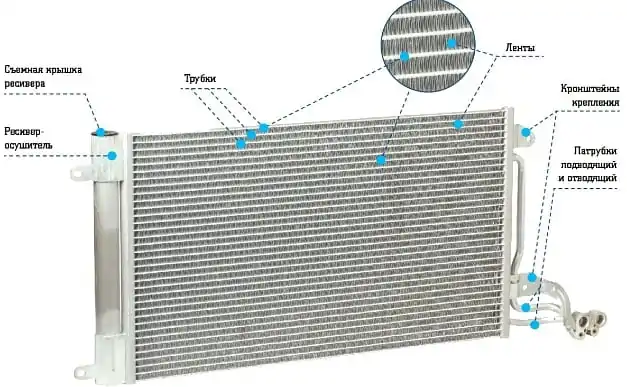

The material from which automobile radiators are made is metal (aluminum or copper). The walls of the heat exchanger are very thin, due to which the antifreeze quickly gives up its temperature and cools.
The radiator design consists of thin tubes welded together in the shape of a rectangle. This element is mounted on two tanks (one at the entrance, the other at the exit). Additionally, plates are strung on the tubes, which increases the heat transfer area. Air passes between the ribs and quickly cools the surface of the part.
All heat exchangers have two openings: inlet and outlet. The system nozzles are connected to them. To drain fluid from the cavity, the heat exchanger is equipped with a plug installed at the bottom of the structure.
If the car is moving along the highway, there is enough air flow to cool the antifreeze naturally (blowing ribs). In the case of movement in the city, the air flow is not so intense. For this, a large fan is installed behind the radiator in the cooling system. In older models of cars, he had a direct drive from the motor. Modern cars are equipped with an antifreeze temperature control system and, if necessary, include forced airflow.
How radiators are made - see in the next video:


Watch this video on YouTube
Types of radiators
There are several types of heat exchangers. Each of them is designed for its purpose, but they work according to one principle - liquid circulates inside them to ensure heat exchange. Here are the car systems used heat exchangers:
- cooling;
- heating;
- climatic.
Most often in the automotive industry, two categories of radiators are used.
- Tubular-lamellar. This is the most common modification that was installed on old cars. The heat exchanger in them consists of horizontally arranged tubes (circular cross section) on which thin plates are strung. Most often they are made of aluminum alloy. These modifications were installed on older cars. The main disadvantage is poor heat transfer due to the small area of contact with the air flow.
- Tubular and tape. They use long tubes (oval section), folded in the shape of a coil. The material used to make them is either an alloy of copper and brass, or aluminum. Such modifications are installed in many modern cars. Copper models have excellent thermal conductivity, but are very expensive. Therefore, more often the cooling system is equipped with aluminum counterparts.
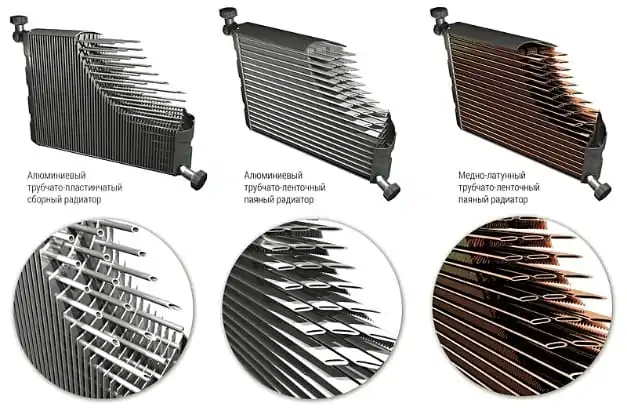

Among the first category, there are two more types of radiators. These are one-way and multi-way models. They differ from each other by the principle of circulation.
- One way. Coolant enters the cavity of the heat exchanger on one side and is evenly distributed throughout all the tubes. They have a significant drawback: the antifreeze in the cavity is distributed unevenly, because of which the efficiency of heat exchange is lost.
- Multi-way. The cooling elements in them are divided into several sections. This design increases the total length of the line, which improves the heat transfer process.
Technical requirements
Since the purpose of the radiator is high-quality heat transfer, this element of the cooling system must meet the following requirements:
- Resistant to oxidative reactions. The walls of the heat exchanger are constantly exposed to aggressive substances (ethylene glycol, which is an integral part of antifreeze, tends to acquire the properties of an acid over time). If the radiator is of poor quality, then it will quickly deteriorate under the influence of an oxidative reaction, because of which it will not be able to withstand the pressure in the cooling system, and in some cars this parameter rises to three or four atmospheres.
- Resistant to high pressure. As mentioned earlier, in some cooling circuits, the antifreeze pressure rises to 4 atm. In order for the new radiator to be able to withstand the peak load and at the same time maintain its tightness, the part is tested at the factory under a pressure of 15 atmospheres.
- Vibration resistant. In any car, parts suffer from constant vibrations. The radiator is no exception. The radiator must withstand vibrations ranging from 5 to 35 hertz.
- Resistant to temperature changes. On a frosty night (depending on the region), the ambient temperature can drop to -30 or more, and with the engine running, the coolant can warm up to +115 or more (depending on the type of system). such drops should not disable the radiator.
Additional options
Some types of radiators can provide cooling for two different systems in a vehicle at once. For example, such devices in their design may have a separate circuit, for example, for cooling the transmission oil of an automatic transmission.
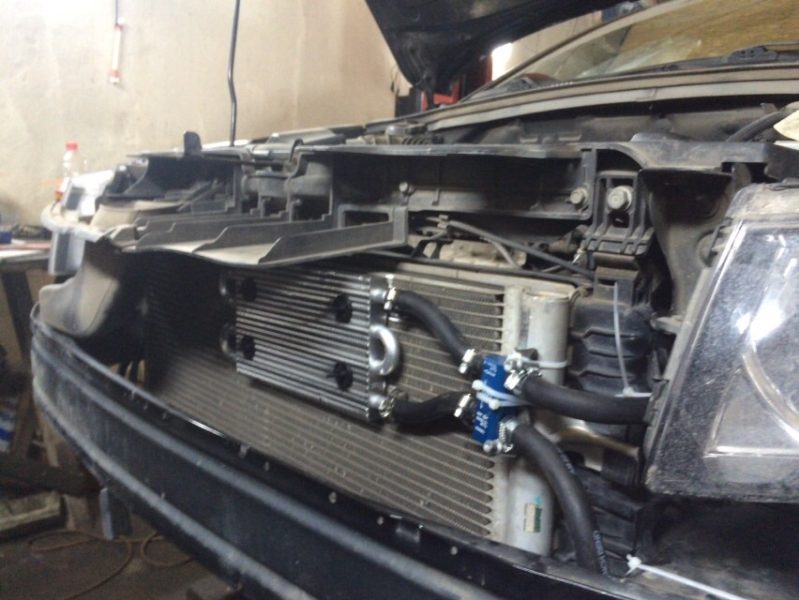

In the technical documentation for the radiator, the manufacturer will definitely indicate if the part has an additional cooling circuit for a separate system. If the car is equipped with air conditioning, then this system uses an individual heat exchanger, which is why it is impossible to install a standard cooling system radiator in some cars. In this case, manufacturers offer thinner heat exchangers for the engine cooling system.
What does the cooling efficiency depend on?
The standard engine cooling system often does not require any manipulations to improve it. In some cases, there is a reason to make some changes. For example, in the northern latitudes in winter, for better engine warm-up, drivers install a hot thermostat that opens at a temperature of +90 degrees.
If it is very hot in summer and the car is prone to boiling antifreeze, then the driver can install a cold thermostat that opens at a temperature of +70 degrees so that the engine reaches maximum temperature longer.
In other situations, the system works quite efficiently. But in extreme heat, and the radiator exists just for this case (to cool the antifreeze and prevent the motor from boiling), the motor may overheat due to poor heat transfer.
The cooling efficiency of antifreeze depends on:
- Cooling radiator designs. The number of tubes, their material, the cross section of the tubes, the position of the plates on the tubes. If the engine compartment allows, then a three-row analogue can be installed instead of a two-row radiator. Thanks to this, the cooling of the system will occur with greater efficiency.
- Artificial blowing of the heat exchanger. This is necessary when the car is moving at low speed, for example, in a city toffee. For efficient airflow, various types of fans are used. Some of them can operate in different rotation modes depending on the required degree of cooling. The most effective option is an electric fan, triggered by a control unit or a temperature sensor. There are also models equipped with a viscous clutch that works at a certain temperature, but they are less effective.
- Cleanliness of the heat exchanger. Since the radiator is located at the very front of the car, a large amount of dust, leaves and other debris on the road gets on its fins. Over time, harmless leaf dust turns into a dense layer of dirt that clogs the empty spaces between the heat exchanger bands. This prevents the free passage of air, due to which the motor will overheat, even with the fan constantly running.
Damage to radiators: causes, prevention
Like any part, the radiator in the car can also fail. Here are five main reasons.
- Mechanical damage. Since this part is installed in front of the car, foreign objects often fall on it. For example, it can be stones from the car in front. Even a slight collision of the machine can damage the radiator, which will violate the tightness of the cooling system.
- The oxidation of metal. Although all elements of the heat exchanger are made of stainless materials, the radiators are not protected against scale formation inside their cavities. Due to the use of low-quality coolant, metal parts of the motor can be oxidized, which clogs the line and interferes with the free circulation of antifreeze.
- Natural wear. Constant heating and cooling leads to the "fatigue" of the metal, which reduces its strength. Vibrations in the engine compartment contribute to the destruction of the joint seams, which can cause a leak.
- Excessive pressure in the line. If a poor-quality plug is installed on the expansion tank, over time the pressure relief valve ceases to function. Due to the heating of antifreeze to a temperature above 100 degrees, the volume in the system increases. Most often, seams on plastic elements diverge. But the walls of the old heat exchanger become thinner over time, which leads to depressurization and leaks.
- Coolant freezing. This can happen if you use the wrong antifreeze or plain water. In frost, water crystallizes and expands. From this, cracks appear on the walls of the tubes.
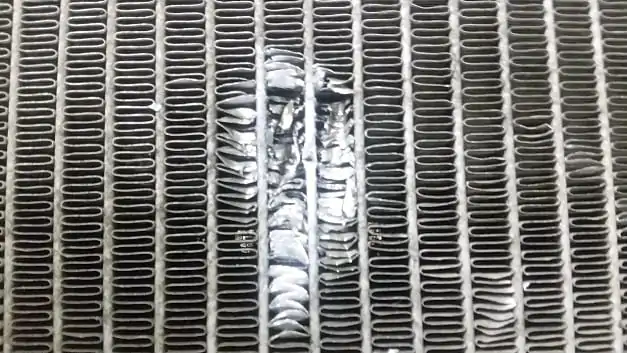

Most of these problems can be prevented by using preventative methods. To extend the radiator service, the car owner can take the following measures.
- Do not pour ordinary water into the system. In an emergency, you can use distilled, but in the near future you need to change it to antifreeze. This liquid boils at a temperature above 115 degrees. In addition, it contains lubricant, which has a beneficial effect on the impeller of the pump and other metal parts of the system.
- Change the antifreeze in a timely manner, and when the level decreases, top up it. Replacement must be done at least 50-70 km. mileage (for antifreeze, this interval is from 000 thousand). But if the coolant has changed its color and turned black, this is a clear signal for system maintenance.
- Install a radiator that is made for this model of car.
- Perform scheduled maintenance of the entire cooling system.
- Keep the heat exchanger fins clean.
- During the replacement of antifreeze, periodically apply flushing of the inner walls of the coil.
How to repair a radiator
There are several methods for repairing radiators of the engine cooling system. it all depends on the degree of damage. In some cases, it will be enough to use special sealing agents, and in others, you cannot do without special equipment.
Here's how to repair a radiator, depending on the nature of the damage:
- External repairs using auto-sealants. For this procedure, you will need to purchase a glue-sealant with metal dust. Such funds can be one- or two-component. Metal sealant or cold welding is another name for such products. Repair with these funds has an effect with minor leaks.
- Internal repairs using chemical sealant. Means intended for such repairs can be liquid or powder. As in the previous case, they can only be used in case of minor leaks. Also, a gap or hole after such a restoration holds a little pressure, so this is a temporary measure.
- Soldering the radiator. Compared to the previous methods, this method is more reliable, but it will take more time and money. And if there is no experience in performing such work, then you will still need to find a specialist. but aluminum radiators are not subject to soldering. This method is suitable for repairing brass variants. The only caveat is that soldering must be performed at a short distance from the factory soldering so that the seam does not melt.
- Damaged tube plug. This repair method is suitable for extensive but localized damage. In this case, the tubes are flattened with pliers. The liquid will continue to circulate, but at high pressure, the leak will not be completely eliminated, and the heat transfer efficiency of the part will slightly decrease (this depends on the number of blocked tubes).
The expensive method should be used only in the case of expensive radiators. Otherwise, there is no point in soldering the part, especially with regard to aluminum models. The reason is that if an aluminum radiator leaks, then after a while it will surely crack.
All of the above repair methods, except for soldering, are temporary measures. They have an effect only for a while, and even then not in all cases with 100% elimination of leaks. This is more likely for an emergency, when the radiator is dripping on the road, and the nearest service station is still a long way to go.
Which is better: repair or change
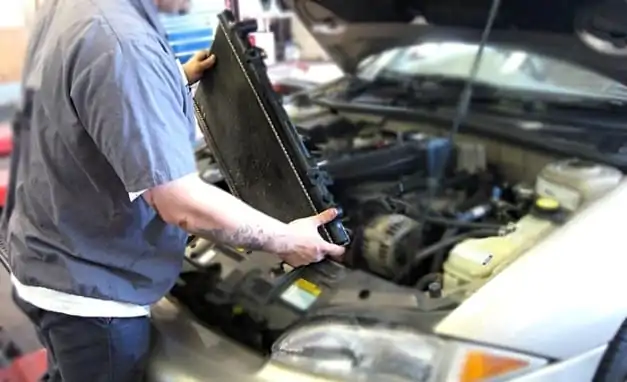

All motorists can be divided into two categories. The first consider that the failed part needs to be replaced with a new one. The second is sure that everything can be repaired. And fixing radiators is a common topic of contention.
The Internet is replete with all kinds of tips for self-repairing leaks. Some use special plastic compounds. Others fill the system with tools designed to plug cracks. Sometimes some methods help temporarily extend the life of the part. But in most cases, these techniques only clog the cooling system.
It makes sense to repair copper models, because they are quite easy to solder. In the case of aluminum analogues, the situation is different. They can be soldered, however, expensive welding will be used for this. Therefore, the cost of repairing a leaked radiator will be almost identical to the price of a new part. To agree to this procedure makes sense only in the case of an expensive heat exchanger model.
In most cases, repair is only a temporary measure, because high pressure constantly arises in the cooling system, which will result from repeated depressurization of the main. If you conduct timely maintenance and cleaning of the system, you often do not have to change the radiator. Therefore, when the part has broken and precious coolant has spilled onto the ground, it is better to replace this unit than to constantly throw money away for the purchase of another canister.
How to operate?
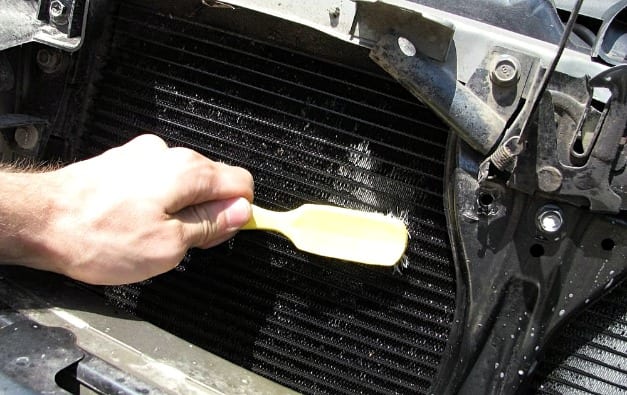

One of the most important conditions for the correct operation of the radiator is to ensure its cleanliness and prevent the occurrence of excessive pressure in the system. The second factor depends on the cap of the expansion tank.
The first procedure can extend the life of this component. However, it must be done correctly.
- The manufacturer categorically prohibits the reuse of used coolant. Even if you clean it, it has already lost its properties, and therefore will already be useless.
- If the antifreeze is very dirty, before pouring a new one into the system, it must be washed with distilled water (in no case should ordinary water be used). It does not contain salts and impurities that can build up inside the coil and reduce cooling efficiency.
- When cleaning the outside, it is important to take into account that the fins of the heat exchanger are very thin and therefore even slight forces can bend them. Subsequently, this will prevent the natural airflow of the radiator pipes. If the procedure is performed using a mini-washer, you need to set up a small head. The jet should be directed perpendicular to the fins to prevent accumulated dirt from moving into the heat exchanger. Then it cannot be purified in any way.
Why do you need to regularly flush the cooling radiator in a car?
Since the efficiency of heat transfer depends on the cleanliness of the radiator, each driver needs to monitor the condition of this part. It is better to do this at the beginning of the season, for example, after winter. In one year, the heat exchanger cells will not have time to clog to a critical degree, but if the car constantly drives on dusty roads, for example, in the forest, then the radiator needs to be cleaned more often.
But in addition to cleanliness on the outside, the radiator must also be clean on the inside. To do this, it is necessary to monitor the timely replacement of the coolant and not use water. Water can form scale. The more it is in the radiator tubes, the worse the coolant will circulate in the system.
This happens if a motorist pours funds into the system of unknown origin that supposedly eliminate a radiator leak. The gust itself may be clogged, but the same thing happens in thin sections of the cooling system.
Extending the life of a radiator: flushing outside and inside
Any equipment requires periodic maintenance. The same goes for cooling radiators. In order for the part to serve longer, it must be periodically cleaned of dirt (on the honeycomb), as well as rinse its cavities.


It is better to combine flushing the radiator with the planned replacement of antifreeze. This is how the procedure is performed:
- The motor must cool down so that the pressure in the line decreases;
- The coolant is drained. The contamination of the cooling system can be judged by the purity of the antifreeze.
- Then the system is completely filled with distilled water. For the best effect, you can add a couple of drops of descaler to it (but it is important that it does not contain acid).
- The motor starts and should run for up to 20 minutes.
- The cleaning water is drained from the system.
- Pure distilled water is poured and the engine starts.
- The procedure is repeated until the drained water is clear.
For external cleaning, the radiator must be disconnected and removed from the machine. Since the radiator honeycombs are made of thin aluminum foil, when using coarse brushes, strong pressure of water and aggressive detergents, they can be deformed, which will make the air flow to the heat exchanger worse.
How to flush a car cooling radiator
It is best to combine flushing the radiator with replacing antifreeze. The sequence of work is as follows:
- The motor must be allowed to cool down so as not to get burned during the procedure, and also to reduce;
- Antifreeze is drained through the faucet in the radiator. By the color of the coolant, you can assess how dirty the system is;
- Distilled water is poured (if the drained antifreeze is dirty). Moreover, in this case, ordinary water cannot be used so that scale does not form inside the tubes. For the best effect, you can add a couple of grams of acid-free descaling agent to the water. It is the acid-free agent that will be gentle on the plastic and rubber elements of the entire system. Also, they will not cause corrosion inside the radiator;
- The engine starts and runs for 15-20 minutes;
- The engine is muffled;
- Water drains. If it is dirty, then the procedure must be repeated until clean water drains after washing;
- Fresh antifreeze is poured;
- To eliminate air locks, the engine starts, and add antifreeze until the level in the expansion tank stops dropping.
For external cleaning of the radiator, you will need to dismantle it. Honeycombs are washed with a small pressure of water. The water pressure must be low so that the pressure does not deform the heat exchanger fins.
Which radiator is better?
In most cases, the answer to this question depends on the material capabilities of the motorist. Copper-brass models lend themselves to inexpensive repairs. Compared with aluminum counterparts, they have better heat transfer properties (copper heat transfer coefficient is 401 W / (m * K), and aluminum - 202-236). However, the cost of the new part is very high due to the price of copper. And another drawback is the large weight (about 15 kilograms).
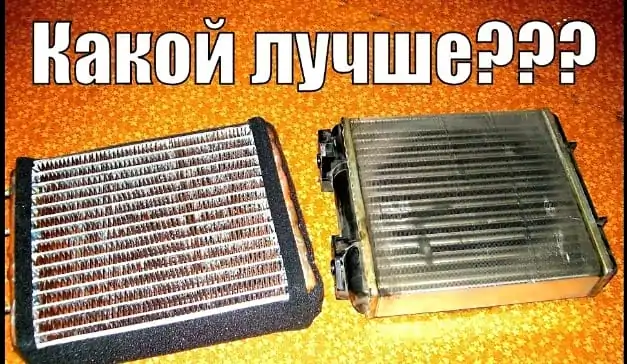

Aluminum radiators are cheaper, they are lighter than copper options (in the region of 5 kg.), And their service life is longer. But they can not be repaired qualitatively.
There is another option - buy a Chinese model. They are much cheaper than the original part for a particular car. Only the main problem with most of them is their short service life. If an aluminum radiator copes with its functions for 10-12 years, the Chinese analogue is three times less (4-5 years).
Radiator leaks: what to do
So, the stable operation of the power unit depends on the health of the radiator. If during the trip the driver noticed that the arrow of the cooling system thermometer sharply went to the maximum indicator, it is imperative to stop and check the condition of the radiator and pipes.
Causes of a radiator leak in a car cooling system
Before undertaking any emergency repair work, you need to establish what is the reason for the radiator leak. This can be a breakdown from a branch or stone. Also, the system may leak due to a rupture of the heat exchanger (a thin tube ruptured due to high pressure) or due to the banal old age of the product.


Usually, minor damage to the radiator is difficult to see. They make themselves felt most often at the most inopportune moment - when the motor is operating under heavy load. A weak leak may not seem so significant to the driver to repair or replace the radiator with a new one. But over time, a small crack will turn into a major gust.
What is the danger of antifreeze leakage from the cooling system of a car
The very first thing that antifreeze leakage leads to is overheating of the motor. Here are some of the problems this problem can lead to:
- To deformation of the cylinder block, the appearance of cracks in it or deformation of the cylinder head;
- To the ICE wedge;
- To deformation or breakdown of the cylinder head gasket;
- To breakdowns in the cooling system with the accompanying failure of its parts.
Regardless of what kind of breakdown appeared due to overheating of the power unit, eliminating these consequences is an expensive procedure.
What to do if the cooling radiator is leaking
In this case, the first thing is to make up for the lack of coolant. In fact, it is a good habit to check the condition of technical fluids before a trip (especially a long one). This will prevent an abnormal situation on the way.
Do not think that a couple of drops of antifreeze on the radiator honeycomb is an insignificant problem. Sooner or later, a serious breakdown is formed. If this happens while the car is moving, the driver may not notice the loss of antifreeze until the engine overheats.
If the driver knows that the radiator is old, and he has already begun to dig in, it is imperative to have a supply of fresh coolant with you. Do not rely on a dozen liters of ordinary water, as it can form scale. In the worst case, distilled water can be added to the system. But then such a liquid needs to be replaced.
Details on breakdowns and maintenance of radiators can be found in the following video:


Watch this video on YouTube
What to do in case of large damage and leaks of the cooling system
If torn pipes became the cause of the leak in the cooling system, then they must be replaced, and the entire set at once. In the event of a radiator rupture, some motorists try to solder the product. But such a repair makes sense if the radiator is very expensive and made of copper.
Soldered aluminum radiators do not last long, because the repair site does not tolerate high pressure in the system, and repeated soldering by a good specialist can be much more expensive than the part itself.
If the engine cooling system is depressurized on the road, then with a slight rush, you can continue driving to the nearest auto parts store or service station. At the same time, you will need to periodically stop and top up with distilled water (you will need to purchase or stock up in advance if there is a suspicion of an impending breakdown).
With a significant leak of antifreeze, it is useless to add water, and it is dangerous to continue driving. Overheating of the engine in this case will result in serious waste for the driver for major repairs. To avoid this, you need to call a tow truck and go to the service station.
How to glue the plastic parts of the cooling system with a leak
The design of some radiators allows you to repair plastic pipes (inlet or outlet). To do this, you can pre-purchase a two-component adhesive-sealant. To many motorists, this tool is known as cold welding.
The composition of such products may include small particles of metal, which ensures maximum strength of the patch. To repair a broken plastic element, you must:
- If necessary, remove the radiator;
- Clean and degrease the repaired area;
- Mix two ingredients. They basically have the structure of plasticine, which hardens after a while. Some materials can be drilled, threaded, or filed after hardening;
- A homogeneous mass is applied to the crack. For the best effect, it is necessary to treat an area larger than the damage itself.
After processing the damage, the material must be dried. For many sealants of this type, three to five minutes is sufficient. Full hardening will be after a maximum of a day.
Is it possible to solder aluminum radiators and how correctly
Aluminum radiators can be soldered, but this process is time-consuming and requires compliance with a certain technology. For this reason, the elimination of leaks in such a heat exchanger must be entrusted to a professional.


In order to correctly solder aluminum, you need to purchase a powerful, expensive soldering iron. Before work, the soldering iron must be well warmed up. The same must be done with the walls of the radiator.
Before soldering the radiator, the damaged area needs to be cleaned well, which can be very difficult if the hole has formed in a corner or on a tube close to the inside of the heat exchanger. In order for the patch to hold firmly, the solder must contain a large amount of tin.
To correctly perform this procedure, the radiator must be removed from the machine. After the repair of the heat exchanger is completed, the cooling system is filled with fresh antifreeze.
Eliminating antifreeze leakage in the cooling system using a special sealant
If a small leak has appeared in the radiator, then it can be eliminated without dismantling the heat exchanger and time-consuming repair work. For example, you can use a sealant from Liqui Moly (Kuhler-Dichter). Such products are able to seal porous metal, small cracks and small fistulas. They are compatible with other additives and do not react with them.


Before purchasing such a sealant, it is necessary to clarify: such products are effective only in case of minor damage. Said agent consists of plastic crumbs in a solution of monoethylene glycol. It dissolves in water. Upon contact with air and pressure drops, the substance polymerizes at the leak site.
Unlike folk remedies such as egg white or dry mustard, this sealant does not block the thin channels of the engine cooling jacket. It can be permanently in the cooling system. Its polymerization occurs only in the presence of high pressure and contact with oxygen.
Related videos
This video shows the procedure for soldering an aluminum heatsink:


Watch this video on YouTube
Questions and answers:
What is a radiator in a car? A radiator is a heat exchanger with hollow tubes inside which the engine coolant circulates. When the engine is running, the pump pumps coolant from the engine cooling jacket to the radiator and vice versa. This part is designed to cool antifreeze or antifreeze so that the motor does not overheat. Another analogue is used in the car heating system. This radiator is also connected to the engine cooling system, only in this case the heat coming out of the heat exchanger is used to heat the passenger compartment. Some other systems are also equipped with a radiator, for example, an automatic transmission in many cars is also equipped with a cooling radiator.
Where is the radiator in the car? Since in order to effectively cool the liquid in the heat exchanger, it must be constantly blown with air, it is most practical that this part is in the front of the machine. The heating radiator can be installed in different places of the machine. It depends on the car model. In some cases, this element is located under the windshield behind the dashboard, in others - in the lower part behind the center console. There are cars in which the heater radiator is installed in the engine compartment.

3 comment
Stalin
Very good information, luxury, excellent work for sure, it took time to write it, thank you very much.
anonym
What is the relationship between the radiator and the engine?
anonym
Thank you very much